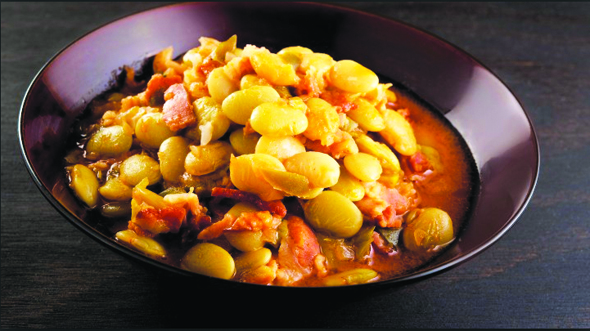Mama’s Punjabi Recipes: Lima Bean Di Kurri (Lima Bean Curry)
India is truly a vegetarian’s delight, as you never have to search the menu at a restaurant for something meatless to order. Thanks to warm weather, in India you can find most types of tropical vegetables and fruits that are common all across Asia, except for a few items like the interesting looking dragon fruit, green bok choy or foul smelling but sweet durian. To this you could add the simple lima bean, which I have seldom seen in markets in North India.
Lima beans are commonly found in the US where they are also called butter beans, for their starchy yet buttery texture, and come in small and large sizes. They are another vegetable that came from the New World – like tomatoes and corn – and have their origin in the Andes of South America. The broad, large beans came from the north of Peru and so are called ‘Lima Beans” after the capital.
Lima beans are a high source of dietary fiber and are a virtually fat-free source of high-quality protein. They contain soluble fiber which helps regulate blood sugar level so that it does not rise too rapidly after eating the beans, and lowers cholesterol. Lima beans also contain insoluble fiber which aids in the digestive process and preventing constipation. They also contain folate and magnesium which help reduce heart problems.
I had no idea that lima beans were so beneficial and when I made a curry with them, I was surprised that they also taste good. You can easily find frozen bags of lima beans in grocery stores and so the basic curry recipe is quick and easy to make. Don’t confuse the large lima beans with fava beans which have a hard skin and are eaten either roasted or cooked in a sauce. Just make sure that the consistency of the turri should not be too thick and especially not thin like water.
Ingredients :
1 small bag lima beans (large or small size; frozen- do not thaw)
2 medium piyaaz (onion) – peeled and finely chopped
1 tbsp tamater paste (tomato paste)
2 cloves of lasan (garlic) – peeled and finely chopped
1 tablespoon adrak (ginger) – peeled and finely chopped
2 tablespoons of vegetable or olive oil
2 cups of water
Spices (to taste): namak (salt), mirch (red pepper), haldi (turmeric), dhania (coriander), garam masala
Directions:
1. In a medium saucepan prepare the masala in a medium frying pan. Heat 2 tablespoons of oil over medium heat, then add the onions, ginger, garlic and tomato paste. Stir well to make sure it doesn’t stick to the bottom. When the mixture is slightly brown, add the haldi and red pepper to bring out the color; add the rest of the spices and stir well.
2. Pour the frozen lima beans out of the bag and into the masala and stir fry for 5 minutes.
3. When the beans look slightly roasted, add two cups of warm water and cover the pot and bring the curry to a boil for 5 minutes. Reduce the heat to low and cook for five minutes. Do not overcook the beans as they need to be solid, not smashed.
4. Before serving, sprinkle with garam masala. The dish is ready to eat, usually with roti, rice or any variety of bread.
MAMA’S TIP OF THE WEEK
ADD MILK, NOT WATER, TO THIN OUT DAHIN (YOGURT)
Most Indian meals, at least for large gatherings and parties, have a side dish of raita, which is just thinned down dahin (yogurt) with some additional condiments like piyaaz (onions), tamater (tomatoes), pudina (mint) or boondi (fried chickpea flour drops), with some spices. Raita can help cut down the effect of over spiced dishes and also aids in digestion.
But the process of making raita requires a little consideration for what the final consistency and taste should be. If you add water – especially cold water – the raita will become watery and will separate after a little while, the water rising to the top. It is better to use some milk to thin out the yogurt: it adds more flavor and doesn’t separate out so easily.
Shakuntla Malhotra is a skilled cook of Punjabi dishes made in the old-fashioned style that she learnt as a young woman in her ancestral home in Lyallpur, India before it became part of Pakistan after the Partition in 1947. People have often admired her cooking for its simplicity and taste that comes with each mouthful. Even in her mid-eighties, she continues to cook daily and agreed to share some of her delectable Punjabi recipes.


